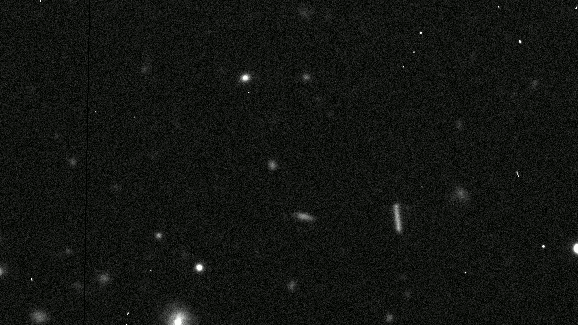
Until we live in a world based purely on sliding doors, door hinges will remain some of the most unsung heroes of our society. We'd still be able to saunter through door frames, sure, but nothing would so seamlessly connect the place we once were with the place we are going. On a metaphorical level, door hinges represent an intermediate state we use to move back and forth, and decide when to lock ourselves in the locations of here or there.
It is thus only fitting for a goddess to be named for none other than the door hinge: Cardea. And now, thanks to Clay Chilcutt, a student at the University of Georgia, there is a cosmic object named for this goddess.
Chilcutt was the winner of a naming contest created by the International Astronomical Union — the organization in charge of formally naming space phenomena — and the popular science podcast Radiolab. The goal was to find a name for one of Earth's seven known quasi-moons; its provisional designation was the very catchy title of 2004 GU9.
Quasi-moons are "moons" that orbit planets and seem to behave like regular moons at first glance. In truth, however, a quasi-moon follows an orbit around the sun (like an asteroid would) rather than the respective planet itself (like a standard old moon would). The mooniness of a quasi-moon is simply an illusion. (The most famous quasi-moon of Earth is probably Kamo'oalewa, which could actually have true lunar origins.)
Chilcutt submitted the name Cardea for the particular quasi-moon 2004 GU9 — and won.
"Before this assignment, Cardea was completely unknown to me." Chilcutt told Space.com. "This whole thing happened because of an extra credit assignment for my astronomy class at UGA. I figured I'd put in just a little effort and it ended up going a long way."
In the official submission, Chilcutt wrote: "Cardea presides over transitions and liminal spaces. A quasi-moon occupies a unique orbital path, existing in a transitional state between a true moon and an independent asteroid. She symbolizes change, guardianship, and the passage between realms. This name reflects the quasi-moon's unique orbital path, embodying a celestial gateway between Earth and space."

Cardea was up against six other finalists in the 2004 GU9 name contest, each of which has an equally rich history.
There was "Bakunawa," in reference to a moon-eating, serpent-like dragon in Filipino mythology that's said to cause eclipses and earthquakes, and Ehaema, calling on a nocturnal spirit in Estonian mythology. There was also Enkidu, a legendary figure and friend of the iconic Gilgamesh in Mesopotamian (Sumerian) mythology and Ótr, who, in Norse mythology, could take any form but usually picked that of an otter. The last options were Tarriaksuk, in reference to humanoid shadow beings that exist in another dimension, according to Inuit mythology, and Tecciztecatl, a lunar deity representing the "man on the moon" in Aztec mythology.
"When I had heard I won I was honestly very shocked. I almost couldn't believe it," Chilcutt said. "It's a very unique experience to say I've left my mark on history and made a contribution to science."
The jury of cosmic nomenclators for this contest was robust and quite diverse in discipline. Co-host of Radiolab, Latif Nasser, was arguably the orchestrator of it all because he's the reason 2004 GU9 started on its road to earning a name in the first place. Last year, Nasser managed to name a quasi-moon of Venus, numerically tagged as 2002 VE, "Zoozve." If you didn't notice in that sentence, Zoozve is the letter version of 2002 VE, if you think of the 2's as Z's and the 0's as O's. There's a lovely story about why that's the case.
When putting his son to bed one day, Nasser had been looking at a solar system poster on the wall. According to this poster, Venus had a moon named "Zoozve." That's not possible, Nasser thought to himself, because Venus is moonless. It was eventually revealed that Nasser was simply misreading the poster. It depicted Venus with a natural satellite, yes, but that satellite was named 2002 VE. Nasser's mind just made up "Zoozve." This story went viral on social media, bringing people together in cosmic serendipity online. So, Nasser asked the IAU if the moment could be christened by actually naming 2002 VE Zoozve. Ultimately, the answer was yes — and here we are now.
It makes sense why Nasser was inspired to name yet another quasi-moon in our solar system, particularly through a contest that lets a space-lover pick said name.
"We did it! A new year and a new (quasi) moon name! Who better to help usher us through this liminal time than an ancient doorkeeper? This whole naming contest has been a true celebration of what Radiolab is all about — curiosity and enthusiasm for the mysterious universe around us," Nasser said in a statement. "We hope that this quasi-moon name continues to inspire people to learn more about space and science in general, to look up together to remember the universal things we all share."
Meanwhile, other members of the jury included Gossip Girl actor Penn Badgley, theoretical physicist Sean Carroll, astrophysicist Wanda Diaz Merced — and, to Chilcutt's delight, Bill Nye the Science Guy.
"I later found out Bill Nye was on the panel of experts that Radiolab and the International Astronomical Union put together to select the finalists," Chilcutt said. "It was a truly humbling experience."







